Santa Cruz Formation
| Santa Cruz Formation | |
|---|---|
| Stratigraphic range: Burdigalian-Langhian (Santacrucian-Friasian) ~ | |
 | |
| Type | Geological formation |
| Sub-units | Estancia La Costa Member, Estancia La Angelina Member (coastal section) |
| Underlies | Cerro Boleadoras Formation |
| Overlies | Monte Léon Formation |
| Thickness | Over 295 metres |
| Lithology | |
| Primary | |
| Location | |
| Country | Argentina, Chile |
| Extent | Austral Basin |
| Type section | |
| Named by | Furque & Camacho |
| Location | near Lago Argentino |
| Year defined | 1972 |
 Santa Cruz Province in Argentina, where the majority of the formation of exposed | |
The Santa Cruz Formation is a geological formation in the Magallanes/Austral Basin in southern Patagonia in Argentina and in adjacent areas of Chile. It dates to the late Early Miocene epoch, and is contemporaneous with eponymous Santacrucian SALMA. The formation extends from the Andes to the Atlantic coast. In its coastal section it is divided into two members, the lower, fossil rich Estancia La Costa Member, which has a lithology predominantly consisting of tuffaceous deposits and fine grained sedimentary claystone and mudstone, and the upper fossil-poor Estancia La Angelina Member, which consists of sedimentary rock, primarily claystone, mudstone, and sandstone. The environment of deposition is interpreted to have been mostly fluvial, with the lowermost part of the Estancia La Costa Member being transitional between fluvial and marine conditions. The environment of the Estancia La Costa Member is thought to have been relatively warm and humid, but likely became somewhat cooler and drier towards the end of the sequence. The Santa Cruz Formation is known for its abundance of South American native ungulates (astrapotheres, litopterns, notoungulates), as well as an abundance of rodents, xenarthrans (armadillos, sloths, anteaters), and metatherians.
Stratigraphy
The Santa Cruz Formation is exposed in isolated outcrops across the Magallanes/Austral Basin extending from the Atlantic coast to the Andes, especially along the Santa Cruz River, as well as along the southern coastline of Santa Cruz Province. While primarily located in Argentina, small outcrops are also present in adjacent areas of Chile. The base of the formation is defined by a marine regression event transitioning from the marine environment of the underlying Monte Léon Formation, during which time large areas of Patagonia were submerged as a part of the Patagoniense Transgression. The main source of sediment input to the basin was from the Andean orogeny to the west. The formation reaches a maximum thickness at any one locality of over 295 metres, though the total thickness of the formation is strongly controlled by subsequent erosion and the 295 metres likely does not represent a complete sequence. The formation primarily consists of floodplain deposits. The lower parts of the formation have an abundance of tuffs and tuffaceous sediments. These likely originated from distant eruptions that were transported into the basin by aerial fallout, wind or river transport. The formation is suggested to span an approximately 3 million year interval in the late Early Miocene around 18 to 15.2 million years ago, during the Burdigalian and Langhian stages.
Paleoenvironment
The environment of the Santa Cruz Formation is thought to have been relatively warm and humid, to have included a mix of open savannah, gallery forests and semi-deciduous forests. Permanent bodies of water such as lakes, ponds and streams are likely to have been present in some areas.
Paleoflora
| Name | Species | Locality | Material | Notes | Image |
|---|---|---|---|---|---|
| Nothofagus | Indeterminate | Rincón del Buque, Punta Sur | Leaves, wood | ||
| Araucaria | Indeterminate | Punta Sur | Twig | Morphologically similar to A. marensii from the Eocene of Antarctica | |
| Lauraceae | Indeterminate | Punta Sur | Wood | Assigned to form genus Laurinoxylon | |
| Myrceugenia | M. chubutense | Punta Sur | Wood | A member of the family Myrtaceae | |
| Eucryphiaceoxylon | E. eucryphioides | Punta Sur | Wood | Wood probably belonging to the genus Eucryphia | |
| Faboideae | Indeterminate | Punta Sur | Wood | Possible affinities to Sophora (Fabaceae) | |
| Doroteoxylon | D. vicenti-perezii | Punta Sur | Wood | Wood with affinities to the subfamily Caesalpinioideae | |
| Akanioxylon | A. santacrucensis | Punta Sur | Wood | A member of the family Akaniaceae | |
| Chloridoideae | Indeterminate | Phytoliths | Grass | ||
| Panicoideae | |||||
| Danthonioideae | |||||
| Pooideae |
Paleofauna
Invertebrates
| Name | Species | Material | Notes | Image |
|---|---|---|---|---|
| Crassostrea | C. orbignyi | Numerous individuals in large beds at the base of the formation | A marine true oyster | |
| Diplodon | D. cf. colhuapiensis | A freshwater bivalve belonging to Hyriidae | ||
| Stephadiscus | Indeterminate | A terrestrial gastropod belonging to Charopidae | ||
| Gastrocopta | G.patagonica | A terrestrial gastropod belonging to Vertiginidae | ||
| ?Scolodonta | Indeterminate | A terrestrial gastropod belonging to Scolodontidae | ||
| Punctum | P. patagonicum | A terrestrial gastropod belonging to Punctidae | ||
| Zilchogyra | Z. miocenica | A terrestrial gastropod belonging to Charopidae | ||
| Patagocharopa | P. enigmatica | A terrestrial gastropod of uncertain affinities, possibly a member of Charopidae | ||
| Porifera | Unspecified | Spicules | Freshwater sponge | |
| Bacillariophyceae | Unspecified | Frustules | Freshwater diatoms | |
| Chrysophyceae | Unspecified | Freshwater algae |
Amphibians
| Name | Species | Locality | Material | Notes | Image |
|---|---|---|---|---|---|
| Calyptocephalella | C. cf. canqueli | Estancia La Costa, Rinconada de los López | Skull and jaw fragments | A calyptocephalellid frog | |
| Neobatrachia | Indeterminate | Estancia La Costa | Skull fragments and presacral vertebrate | A frog originally assigned to "Leptodactylidae", but requires further investigation |
Birds
| Name | Species | Locality | Material | Notes | Image |
|---|---|---|---|---|---|
| Anisolornis | A. excavatus | A bird of uncertain affinities, authors have varyingly suggested affinities to trumpeters or limpkins | |||
| Ankonetta | A. larriestrai | Partial tarsometatarsus | A basal member of Anatidae | ||
| Badiostes | B. patagonicus | A member of the family Falconidae | |||
| Brontornis | B. burmeisteri | Controversial taxonomic position, either considered a terror bird or an anserimorph |  | ||
| Dryornis | D. pampeanusD. hatcheri | Two partial left humerus | A New World vulture. | ||
| Eutelornis | E. patagonicus
E. australis |
Limb fragments | A member of Anseriformes, relationships of the species to each other or to other Ansiferiformes is uncertain | ||
| Liptornis | L. hesternus | A member of Anhingidae | |||
| Macranhinga | Indeterminate | A member of Anhingidae | |||
| Miocariama | M. santacrucensis | Partial cranium and tibiotarsi fragments | A seriema | ||
| Nothurinae | 2 Indeterminate species | Tinamou | |||
| Opisthodactylus | O. patagonicus | Limb, vertebra and skull fragments | A member of Rheidae | ||
| Patagornis | P. marshi | A terror bird |  | ||
| Phorusrhacos | P. longissimus | Partial skulls | A terror bird |  | |
| Protibis | P. cnemialis | distal end of tibiotarsus | Potentially a spoonbill | ||
| Psilopterus | P. lemoinei
P. bachmanni |
A terror bird |  | ||
| Thegornis | T. musculosus
T. debilis |
A member of the family Falconidae | |||
| Archaeopsophia | A. aoni | A member of the family Psophiidae (trumpeters) | |||
| Chehuenia | C. facongrandei | A roller | |||
| Kaikenia | K. mourerchauvirea | An anatid belonging to the subfamily Tadorninae | |||
| Peioa | P. australis | A member of Anseriformes. |
Reptiles
| Name | Species | Locality | Material | Notes | Image |
|---|---|---|---|---|---|
| Pristidactylus | Indeterminate | La Cueva | Fragmentary jaw bones | Originally assigned to the dubious genus "Erichosaurus" | |
| Pleurodonta | |||||
| Tupinambis | Monte León | Fragmentary dentaries and maxilla | A teiid lizard | ||
| Colubridae | Cerro Observatorio | Partial trunk vertebrae | A snake |
Mammals
Meridiungulates
Astrapotheres
| Name | Species | Locality | Material | Notes | Image |
|---|---|---|---|---|---|
| Astrapotherium | A. magnum
A. nanum A. sp. |
An astrapotheriid | 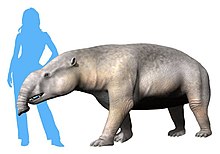 |
Litopterns
| Name | Species | Locality | Material | Notes | Image |
|---|---|---|---|---|---|
| Adianthus | A. bucatus | An adianthid litoptern | |||
| Anisolophus | A. australis
A. floweri |
A proterotheriid litoptern | |||
| Diadiaphorus | D. majusculus
D. sanctaecrucis D. sp. |
A proterotheriid litoptern |  | ||
| Tetramerorhinus | T. cingulatum
T. fleaglei T. mixtum T. lucarius T. prosistens T. sp. |
Estancia La Costa Member | A proterotheriid litoptern |  | |
| Theosodon | T. fontanae
T. garretorum T. gracilis T. karaikensis T. lydekkeri T. patagonicum |
Estancia La Costa Member | A macraucheniid litoptern |  | |
| Thoatherium | T. minisculum
T. sp. |
Estancia La Costa Member | A proterotheriid litoptern |  |
Notoungulates
| Name | Species | Locality | Material | Notes | Image |
|---|---|---|---|---|---|
| Adinotherium | A. ovinum
A. robustum A. sp. |
A toxodontid notoungulate |  | ||
| Cochilius | C. sp. | An interatheriid notoungulate |  | ||
| Hegetotherium | H. mirabile
H. sp. |
A hegetotheriid notoungulate |  | ||
| Homalodotherium | H. cunninghami | A homalodotheriid notoungulate |  | ||
| Interatherium | I. anguliferum
I. brevifrons I. dentatum I. interruptum I. robustum I. rodens I. supernum |
An interatheriid notoungulate |  | ||
| Neoicochilus | N. undulatus | An interatheriid notoungulate | |||
| Nesodon | N. imbricatus | A toxodontid notoungulate | 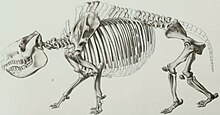 | ||
| Notohippus | N. toxodontoides | A notohippid notoungulate | |||
| Pachyrukhos | P. moyani | A hegetotheriid notoungulate |  | ||
| Patriarchus | P. palmidens | An interatheriid notoungulate | |||
| Protypotherium | P. attenuatum
P. australe P. praerutilum P. sp. |
An interatheriid notoungulate |  |
Xenarthrans
Pilosa
| Name | Species | Locality | Material | Notes | Image |
|---|---|---|---|---|---|
| Analcimorphus | A. giganteus
A. inversus |
Estancia La Costa Member | A basal megatherioid sloth |  | |
| Analcitherium | A. antarcticum | Estancia La Costa Member | A scelidotheriid sloth | ||
| Eucholoeops | E. fronto
E. ingens E. litoralis E. titans |
Estancia La Costa Member | A megalonychid ground sloth |  | |
| Hapalops | H. longiceps
H. elongatus H. indifferens H. angustipalatus H. platycephalus H. ponderosus H. rectangularis |
A ground sloth belonging to Megatherioidea | 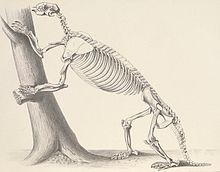 | ||
| Hyperleptus | Indeterminate | A megatherioid ground sloth of uncertain affinities | 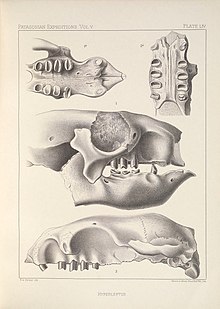 | ||
| Megalonychotherium | M. atavus | A megalonychid ground sloth |  | ||
| Mylodontidae | Indeterminate | ||||
| Nematherium | N. angulatum | A ground sloth belonging to Mylodontoidea | 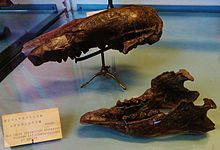 | ||
| Pelecyodon | P. cristatus | A ground sloth |  | ||
| Planops | P. magnus | A megatheriid ground sloth |  | ||
| Protamandua | P. rothi | An anteater | |||
| Prepotherium | P. potens
P. filholi |
A ground sloth |  | ||
| Megalonychidae | Indeterminate | A ground sloth | |||
| Schismotherium | S. fractum | A ground sloth | |||
| Xyophorus | X. atlanticus
X. latirostris |
A nothrotheriid ground sloth |
Cingulata
| Name | Species | Locality | Material | Notes | Image |
|---|---|---|---|---|---|
| Anantiosodon | A. rarus | An armadillo | |||
| cf. Asterostemma | cf. A. depressa | A glyptodont | |||
| Cochlops | C. muricatus | A glyptodont |  | ||
| Eucinepeltus | E. petesatus | A glyptodont | |||
| Metopotoxus | M. laevatus | A glyptodont | |||
| Parutaetus | P. sp. | An armadillo | |||
| Peltephilus | P. ferox
P. giganteus P. nanus P. pumilus P. strepens |
A horned armadillo |  | ||
| Proeutatus | P. carinatus
P. deleo P. lagena P. oenophorus P. robustus |
An armadillo |  | ||
| Propalaehoplophorus | P. australis
P. incisivus P. minus |
A glyptodont |  | ||
| Prozaedyus | P. exilis
P. proximus |
An armadillo |  | ||
| Stenotatus | S. patagonicus | An armadillo | 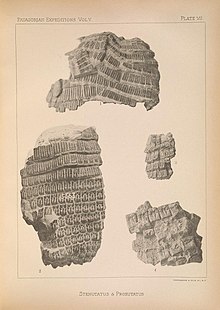 | ||
| Stegotherium | S. tauberi
S. tessellatum |
An armadillo |  | ||
| Vetelia | V. puncta | An armadillo |  |
Metatherians
| Name | Species | Locality | Material | Notes | Image |
|---|---|---|---|---|---|
| Abderites | A. meridionalis | A member of Abderitidae (Paucituberculata) | |||
| Acdestis | A. owenii A. lemairei | A member of Palaeothentidae (Paucituberculata) | |||
| Acrocyon | A. sectorius | A borhyaenid sparassodont | |||
| Acyon | A. tricuspidatus | A hathliacynid sparassodont | |||
| Arctodictis | A. munizi | A borhyaenid sparassodont | |||
| Borhyaena | B. tuberata | A borhyaenid sparassodont |  | ||
| Cladosictis | C. patagonia | A sparassodont | |||
| Lycopsis | L. torresi | A sparassodont | |||
| Microbiotherium | M. acicula
M. patagonicum M. gallegosense M. tehuelchum |
A member of Microbiotheriidae (Microbiotheria) | |||
| Palaeothentes | P. aratae
P. minutus P. intermedius P. lemoinei P. pascuali |
A member of Palaeothentidae (Paucituberculata) |  | ||
| Perathereutes | P. pungens | A hathliacynid sparassodont | |||
| Phonocdromus | P. gracilis | A member of Pichipilidae (Paucituberculata) | |||
| Prothylacinus | P. patagonicus | A sparassodont |  | ||
| Pseudonotictis | P. pusillus | A hathliacynid sparassodont | |||
| Sipalocyon | S. gracilis
S. obusta |
A hathliacynid sparassodont | |||
| Stilotherium | S. dissimile | A member of Caenolestidae (Paucituberculata) |
Rodents
| Name | Species | Locality | Material | Notes | Image |
|---|---|---|---|---|---|
| Acarechimys | A. minutus
A. minutissmus A. constans A. gracilis |
A member of Octodontoidea | |||
| Acaremys | A. murinus
A. messor |
A member of Acaremyidae (Octodontoidea) | |||
| Adelphomys | A. candidus | A member of Octodontoidea | |||
| Dudumus | Indeterminate, potentially new species | A member of Octodontoidea | |||
| Eocardia | E. montana
"E". excavata "E". fissa |
A member of Cavioidea |  | ||
| Neoreomys | N. australis | A member of Cavioidea | |||
| Perimys | P. erutus
P. onustus P. incavatus |
A member of Chinchilloidea |  | ||
| Phanomys | P. mixtus
P. vetulus |
A member of Cavioidea | |||
| Pliolagostomus | P. notatus | A member of Chinchilloidea | |||
| Prolagostomus | P. pusilllus | A member of Chinchilloidea | |||
| Prospaniomys | Indeterminate, potentially new species | A member of Octodontoidea | |||
| Pseudoacaremys | P. kramarzi | A member of the family Acaremyidae (Octodontoidea) | |||
| Schistomys | S. erro | A member of Cavioidea | |||
| Sciamys | S. principalis
S. varians S. latidens |
A member of the family Acaremyidae (Octodontoidea) | |||
| Scleromys | S. angustus | A member of Chinchilloidea | |||
| Spaniomys | S. riparius
S. regularis |
A member of Octodontoidea | |||
| Steiromys | S. dentatus
S. duplicatus |
A member of Erethizontoidea |
Primates
| Name | Species | Locality | Material | Notes | Image |
|---|---|---|---|---|---|
| Homunculus | H. patagonicus, H. vizcainoi | A New World monkey | |||
| Killikaike | K. blakei | A New World monkey, some authors regard the taxon as a synonym of Homunculus patagonicus, while others regard them as distinct. |  |
Meridiolestida
| Name | Species | Locality | Material | Notes | Image |
|---|---|---|---|---|---|
| Necrolestes | N. patagonicus | Skull and postcranial remains | A mole-like meridiolestidan, youngest known member of the group |  |